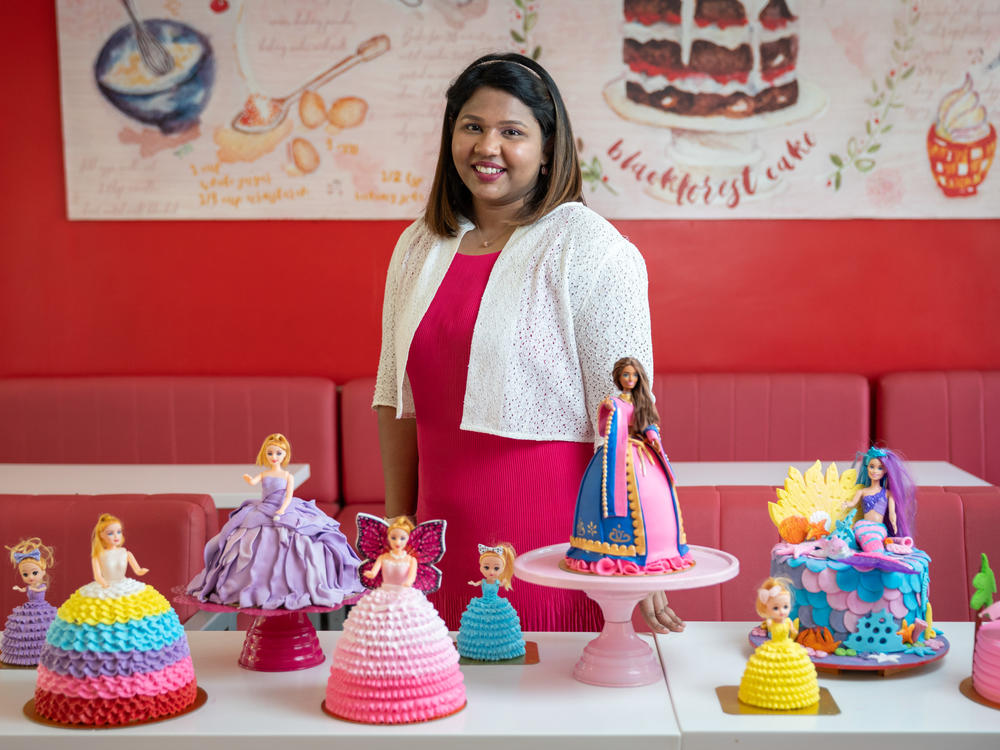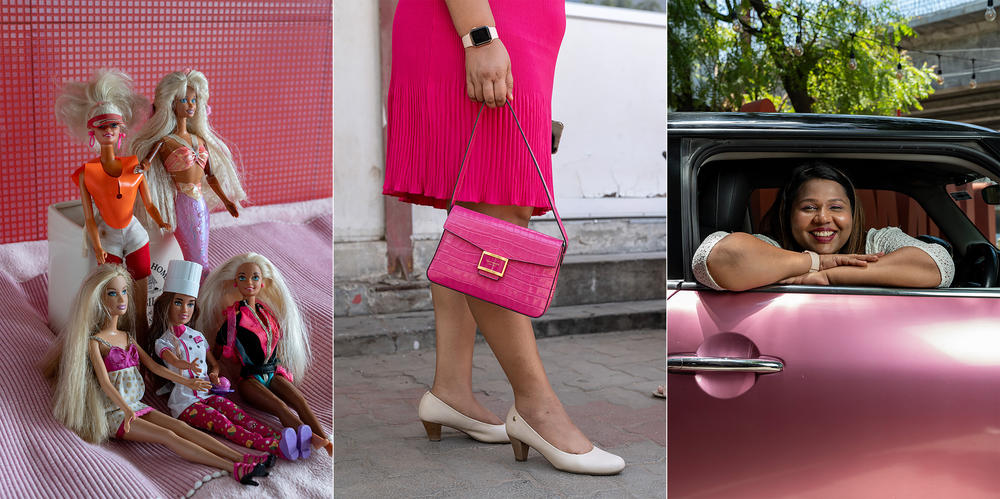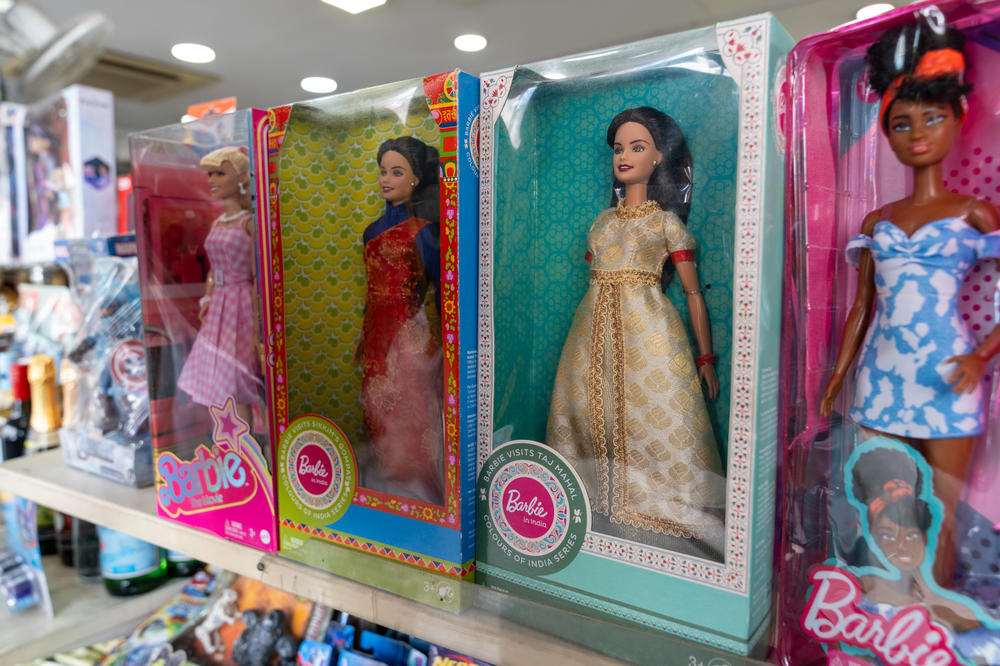Section Branding
Header Content
Barbie in India: A skin color debate, a poignant poem, baked in a cake
Primary Content
She's one of India's biggest Barbie fans. When Vichitra Rajasingh was growing up, family and friends helped her build her collection of Barbie dolls until she had almost 80 of them. She once owned a Barbie camper, a speedboat, supermarket and post office. The mermaid Barbie and scuba-diving Barbie were her favorites.
Since her family ran a hotel, they put the dolls on display in the lobby in the late '90s. On Rajasingh's 14th birthday, her parents painted her room bright pink and hired artists to draw her favorite Barbie dolls on the walls.
All her Barbies were blond. She says she didn't like the Indian ethnic ones that came on the local market.
Living the pink life
"My love for the color pink began with my childhood passion for Barbie," she says. "And now it's become my identity." For her, the color represents love, joy, femininity and playfulness, everything she once associated with Barbie, she says.
Today Rajasingh lives in the southern Indian city of Madurai, where she drives a pink mini-Cooper and runs a bakery and lives in an apartment that are dominated by that color.
When the Barbie movie released in India on July 21, she gathered a bunch of friends, "everyone dressed to the nines in pink," and watched it on the day of its release. "I loved the movie. It was fun to watch and brought back many joyful childhood memories," she says.
While she no longer has her huge doll collection — having long since given it away to family and friends — Rajasingh is still a Barbie lover. She bakes six or seven Barbie-themed cakes a week, with an actual doll at the center of a cake that serves as her frothy dress, constructed around her in a swirl of sugar and cream.
Rajasingh saw Barbie as an aspirational figure — and grew up admiring the doll's freedom, confidence, globe-trotting lifestyle and even her arched feet in sassy stilettos.
But for others in India, Barbie has a far more complicated legacy.
The pressures Barbie can bring
Shweta Sharan, a writer who lives in Mumbai, admits to being conflicted about whether or not to watch the movie with her 13-year-old daughter, Laasya, who until a year ago ardently loved Barbie but then outgrew playing with dolls.
"I am aware that these dolls have many complicated associations," Sharan says. "Watching my daughter love a doll that looked nothing like her — with blond hair, blue eyes, perfect breasts — I worried if she would always strive to be someone else and feel inadequate."
These worries are valid in the opinion of ElsaMarie DSilva, a social entrepreneur from India and an Aspen fellow. "While Barbie is almost universally loved among girls of all ages, many do aspire to look like her, unconsciously pressurizing young girls to conform to unrealistic body shapes and expectations," she says — a common criticism aimed at Barbie.
Indian Barbie is not a rousing success
Mattel did make an effort to adapt the doll for an Indian market. When Mattel launched Barbie in India in 1991, it was the familiar Western-looking blond-haired blue-eyed Barbie. Then in 1996, they rolled out Indian Barbie, with brown skin. She came either wearing a bright sari or a salwar kameez — a knee-length tunic over fitted trousers.
But the Indian Barbie was not popular. "Indian kids gravitated toward the white-skinned Barbie instead of the brown-skinned one because light-skinned women were considered more beautiful in India and an automatic choice," DSilva says.
She points out how even in Indian clothes, Barbie still had a body that did not represent real women in India or anywhere else — she was way too tall and way too thin.
Priti Nemani, an Indian American attorney living in Chicago, analyzed why Barbie failed so spectacularly in the Indian market in a research paper published in 2011. In addition to the unrealistic, impossibly thin appearance of the doll, she points out how other cultural factors were at play.
"We weren't seeing Indian features on Barbie," she says. "We were seeing white Barbies dipped in brown. And even those brown Barbies didn't last long on the shelves. The latest versions of the Indian Barbie have much lighter skin tone.
Meanwhile, even though blond Barbies sold well, Ken tanked in India. "Indian parents who wouldn't want their daughters in romantic relationships at such an early age weren't going to buy the boyfriend," Nemani says.
In spite of her initial misgivings, Sharan enjoyed the Barbie movie with her daughter, now 13, who especially liked the feminist overtones. Laasya loved the beginning, when they were told "Barbie has a great day everyday. Ken only has a great day if Barbie looks at him."
Barbie inspires a poem
There are other issues about Barbie in India. For many kids, the doll is too expensive.
Ankita Apurva, 26, a writer who grew up in a farming family in Ranchi, a city in the Eastern Indian state of Jharkhand, recalls a childhood bereft of Barbies.
Her parents, who struggled to pay for a good education that they hoped would be her armor against bullying and discrimination, could not afford to buy their daughter a Barbie.
"They weren't in a position to splurge on fancy dolls like a Barbie," she says. She recalls feeling inferior for not owning one of these expensive dolls that would help her connect with other Barbie owners in her circle. It was especially hard for her at lunch when girls would boast about how many dolls they owned.
"I believe that even if children from marginalized communities manage to enter [private] institutions [for the privileged], there are certain social, cultural and economic symbols which are consciously and subconsciously deployed to mark them out, and Barbie, as loved as it is, is definitely one of them," she says.
Over the years, Apurva's family has grown stronger financially. When she saw the global resurgence of interest in Barbie now, she didn't feel angry or alienated, but it did bring back memories of desperately wanting to fit in – and not just because she didn't have a Barbie.
"Growing up, I rarely felt represented in literature or media. If pens or cameras turned toward us, they inadvertently counted us as data: dead bodies of farmers or survivors of violence of umpteen kinds."
As a girl from a farming family in Jharkhand, Apurva felt invisible. And so, she decided to express those emotions. She wrote a poem that she posted on Instagram, not to shame anyone who is privileged enough to own a Barbie but to comfort those who, like her, may have felt left out.
Here are some excerpts:
"Here's to the girls who do not get the Barbie craze,
...
girls who had parents who could not
or did not or choose not
to get them Barbie dolls
...
it's okay,
to not relate to any of it
...
what is not okay are friends ...
who intentionally make you
feel low by asking how many Barbies
you owned as a kid even as they
know you weren't privileged enough
to have them.
...
you are also not "too much" ...
if you feel
that Barbie is a colonial icon
legitimizing racial supremacy
while being a 'white feminist' trope
...
and once again
remember,
you are everything,
they are just Ken
Kamala Thiagarajan is a freelance journalist based in Madurai, Southern India. She reports on global health, science, and development, and her work has been published in the New York Times, The British Medical Journal, BBC, The Guardian and other outlets. You can find her on twitter @kamal_t
Copyright 2023 NPR. To see more, visit https://www.npr.org.



